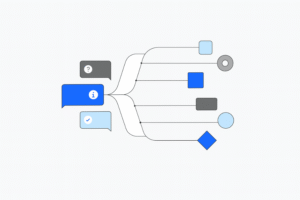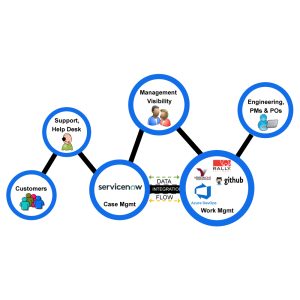In today’s data-driven landscape, businesses grapple with complex processes that weave through various departments and touch multiple systems. These intricate processes generate a wealth of data – a treasure trove of insights waiting to be harnessed. But traditional methods of process analysis often rely on manual data collection, siloed information, and subjective opinions. This limited perspective can lead to a misunderstanding of how processes truly function, hindering efforts to optimize performance.
For instance, manually analyzing mountains of data from various departments is a time-consuming and error-prone process. Additionally, relying on departmental heads or process owners for insights can introduce bias and subjectivity. Process mining cuts through these limitations by leveraging data science and automation to extract a clear and objective picture of how processes actually unfold.
What is Process Mining?
Process mining is a powerful technique that utilizes sophisticated algorithms to extract, analyze, and visualize the actual execution of business processes from event logs. Event logs are essentially digital footprints left behind by various activities within a process. These logs contain timestamps, attributes, and identifiers that capture the who, what, when, and where of each process step. By sifting through these event logs, process mining tools can reconstruct the actual process flow, highlighting deviations from documented procedures and providing a holistic view of process performance.
Here’s a deeper dive into the different stages of process mining:
- Data Extraction: Process mining tools act as data connectors, ingesting data from various sources like enterprise resource planning (ERP) systems, customer relationship management (CRM) software, and application logs. The broader the range of data sources included, the more comprehensive the picture of the process becomes.
- Process Discovery: Unlike traditional methods that rely on pre-defined process maps, process mining discovers the actual process flow based on the data analysis. This data-driven approach can uncover hidden activities, parallel paths, and rework loops that might be missing from documented procedures.
- Conformance Checking: This stage compares the discovered process with the documented process, highlighting any discrepancies or inefficiencies. Deviations from the intended path can signal bottlenecks, rework loops, or areas where compliance risks exist.
- Performance Analysis: Process mining tools go beyond simply revealing the flow of activities. They provide in-depth insights into process performance metrics like cycle time, rework rates, and the time spent at each process step. This granular level of detail empowers businesses to pinpoint the root causes of inefficiencies.
- Process Improvement: Armed with a wealth of real-world data and insights, businesses can identify areas for improvement and implement targeted changes to optimize workflows. Process mining can be used to streamline processes, eliminate bottlenecks, improve handoffs between departments, and ensure adherence to compliance regulations.
Why Choose Process Mining?
Traditional process improvement methodologies often rely on manual analysis and subjective opinions, which can be inaccurate and time-consuming. Process mining offers a compelling alternative with several key advantages:
- Data-Driven Insights: Process mining cuts through the noise by providing objective, data-driven insights into process performance. No more reliance on guesswork or anecdotal evidence. Businesses can finally make informed decisions based on what the data actually reveals about their processes.
- Uncover Hidden Inefficiencies: Traditional methods might miss subtle deviations or inefficiencies that creep into processes over time. Process mining’s ability to analyze vast amounts of event data shines a light on these hidden roadblocks, empowering businesses to address them before they significantly impact performance.
- Improved Transparency: Process mining fosters a data-driven culture by providing a clear picture of how processes actually work across departments. This transparency shatters information silos and facilitates collaboration between teams. When everyone has a shared understanding of how processes flow, they can work together more effectively to identify and implement improvements.
- Enhanced Decision-Making: With process mining’s insights, businesses can make informed decisions about process optimization initiatives. Resources can be allocated efficiently to areas that will yield the greatest impact. Additionally, process mining allows businesses to measure the effectiveness of changes made, ensuring they are on the right track towards achieving their goals.
- Continuous Improvement: Process mining is an iterative process. As businesses implement changes based on the data-driven insights gleaned from process mining, they can use the tool to monitor progress and identify further areas for improvement. This creates a cycle of continuous improvement, where businesses can perpetually refine their processes and achieve operational excellence.
The Ripple Effect of Process Mining: Benefits Beyond Efficiency
Process mining’s impact extends far beyond simply streamlining workflows and boosting efficiency. Here’s how this powerful tool can create a ripple effect of positive change throughout your organization:
- Enhanced Decision-Making: Process mining equips leadership with a clear picture of how processes truly function. This data-driven perspective empowers them to make informed decisions about resource allocation, budget planning, and strategic initiatives.
- Improved Customer Experience: By pinpointing friction points in customer journeys, process mining helps businesses identify and address issues that lead to frustration. This translates to a smoother, more efficient customer experience, fostering loyalty and advocacy.
- Increased Innovation: Traditional process analysis often relies on outdated procedures and ingrained habits. Process mining’s ability to reveal the actual process flow can spark innovation. By uncovering hidden opportunities and inefficiencies, it encourages businesses to explore new approaches and implement creative solutions.
- Empowered Workforce: Process mining fosters transparency by providing employees with a deeper understanding of how their individual tasks contribute to the bigger picture. This empowers them to identify areas where they can improve their own efficiency and contribute to process optimization efforts.
- Risk Mitigation: Process deviations can be a breeding ground for errors and compliance gaps. Process mining helps identify these deviations, allowing businesses to take proactive steps to mitigate risks and ensure adherence to regulations.
- Improved Cost Management: Process mining sheds light on hidden costs associated with inefficiencies, rework loops, and process delays. By identifying these cost drivers, businesses can target them for improvement, leading to significant cost savings.
- Boosted Employee Morale: Inefficient processes can lead to employee frustration and burnout. By streamlining workflows and eliminating unnecessary tasks, process mining can contribute to a more positive and productive work environment, boosting employee morale and engagement.
Process Mining for the Future: Emerging Trends and Applications
Process mining is a rapidly evolving field, constantly expanding its capabilities and applications. Here’s a glimpse into some exciting trends shaping the future of process mining:
- Artificial Intelligence (AI) Integration: AI is becoming increasingly integrated with process mining tools. This allows for advanced capabilities like anomaly detection, pattern recognition, and predictive analytics. By leveraging AI, process mining can anticipate potential issues and recommend proactive solutions.
- Real-Time Process Monitoring: The future of process mining involves real-time monitoring capabilities. This enables businesses to identify and address process deviations as they occur, ensuring continuous optimization and proactive problem-solving.
- Process Mining in the Cloud: Cloud-based process mining solutions are gaining traction due to their scalability, affordability, and ease of access. This makes process mining more accessible to businesses of all sizes, democratizing the benefits of this transformative technology.
- Industry-Specific Solutions: Process mining vendors are increasingly developing solutions tailored to specific industries. These solutions come pre-configured with industry-specific data models and analytics, allowing businesses to gain deeper insights into their unique processes.
- Process Mining and the Internet of Things (IoT): The rise of IoT devices generates a vast amount of data that can be ingested by process mining tools. This data can provide valuable insights into physical processes and how they interact with digital workflows, creating a holistic view of operational performance.
Nexright, as a trusted partner in AI-powered solutions, can guide you through every step of your process mining journey. We offer expertise in selecting the right tools, data preparation, and process analysis.
By leveraging process mining, you can unlock the hidden potential within your organization, achieve operational excellence, and gain a significant competitive advantage.
Ready to transform your business processes ? Contact Nexright today and let’s embark on this journey together.




